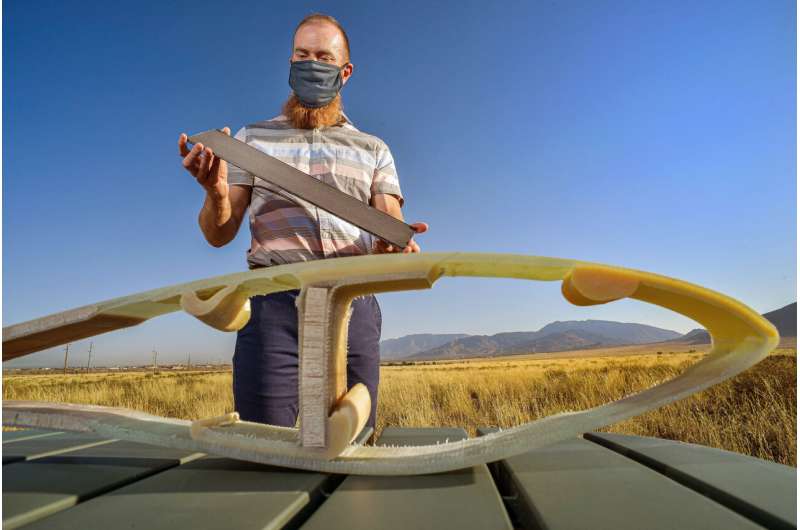Carbon fiber optimized for wind turbine blades could bring cost, performance benefits

A new carbon fiber material could bring cost and performance benefits to the wind industry if developed commercially, according to a study led by researchers at Sandia National Laboratories.
Wind blades containing carbon fiber weigh 25% less than ones made from traditional fiberglass materials. That means carbon fiber blades could be longer than fiberglass ones and, therefore, capture more energy in locations with low wind. A switch to carbon fiber could also extend blade lifetime because carbon fiber materials have a high fatigue resistance, said Brandon Ennis, a wind energy researcher at Sandia Labs and the principal investigator for the project.
The project is funded by DOE's Wind Energy Technologies Office in the Office of Energy Efficiency and Renewable Energy. Partners on the project include Oak Ridge National Laboratory and Montana State University.
Of all the companies producing wind turbines, only one uses carbon fiber materials extensively in their blade designs. Wind turbine blades are the largest single-piece composite structures in the world, and the wind industry could represent the largest market for carbon fiber materials by weight if a material that competed on a cost-value basis to fiberglass reinforced composites was commercially available, said Ennis.
However, the wind and carbon fiber industries do not currently overlap. The wind industry designs wind turbine blades using only commercially available materials and the carbon fiber manufacturers face a hurdle to innovation due to high capital costs associated with introducing a new production line for the wind industry.
Novel low-cost carbon fiber has properties useful for wind industry
Cost is the main consideration during component design in the wind industry, yet turbine manufacturers also have to build blades that withstand the compressive and fatigue loads that blades experience as they rotate for up to 30 years.
Ennis and his colleagues wondered if a novel low-cost carbon fiber developed at Oak Ridge National Laboratory could meet performance needs while also bringing cost benefits for the wind industry. This material starts with a widely available precursor from the textile industry that contains thick bundles of acrylic fibers. The manufacturing process, which heats the fibers to convert them to carbon, is followed by an intermediate step that pulls the carbon fiber into planks. The plank-making pultrusion process creates carbon fiber with high performance and reliability needed for blade manufacturing and also allows for high production capacity.
When the research team studied this low-cost carbon fiber, they discovered it performed better than current commercial materials in terms of cost-specific properties of most interest to the wind industry.
ORNL provided developmental samples of carbon fiber from its Carbon Fiber Technology Facility and composites made from this material as well as similar composites made from commercially available carbon fiber for comparison.
Colleagues at Montana State University measured the mechanical properties of the novel carbon fiber versus commercially available carbon fiber and standard fiberglass composites. Then Ennis combined these measurements with cost modeling results from ORNL. He used those data in a blade design analysis to assess the system impact of using the novel carbon fiber, instead of standard carbon fiber or fiberglass, as the main structural support in a wind blade. The study was funded by the U.S. Department of Energy Wind Energy Technologies Office.
Increased compressive strength brings cost savings
Ennis and his colleagues found that the new carbon fiber material had 56% more compressive strength per dollar than commercially available carbon fiber, which is the industry baseline. Typically, manufacturers accommodate a lower compressive strength by using more material to make a component, which then increases costs. Considering the higher compressive strength per cost of the novel carbon fiber, Ennis' calculations predicted about a 40% savings in material costs for a spar cap, which is the main structural component of a wind turbine blade, made from the new carbon fiber compared to commercial carbon fiber.
The novel carbon fiber even reduced predicted materials costs when compared to fiberglass for a land-based turbine design, due to the improved fatigue resistance. Other results from using the novel carbon fiber in blade design, such as decreased weight and increased fatigue lifetime, could influence the entire turbine design in ways that bring additional cost and performance benefits too, Ennis said.
"While the optimal carbon fiber for the wind industry does not exist on the market yet, this new textile carbon fiber has performance characteristics that have higher value for the specific loads that a wind turbine experiences," Ennis said. "Developing this material commercially could enable the benefits of carbon fiber materials to be realized more broadly by the wind industry and lower the overall cost of wind energy."

















